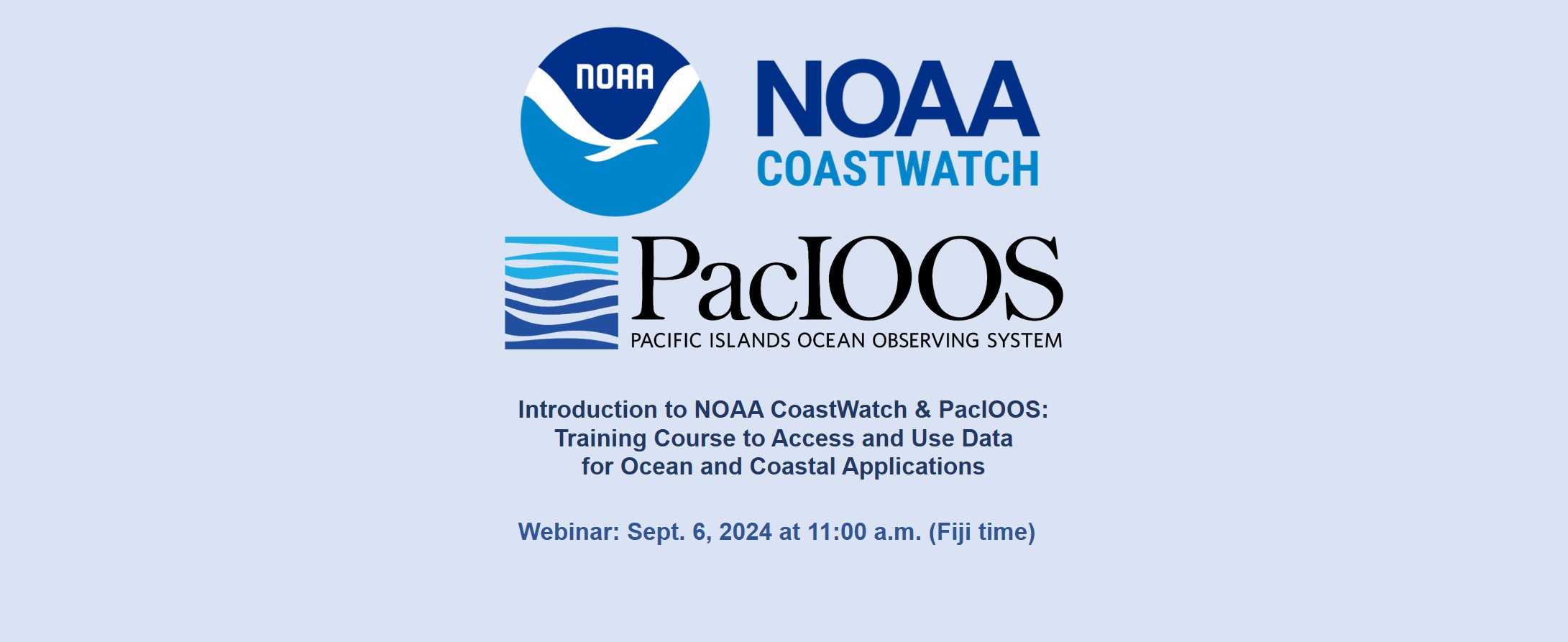Please join the National Oceanic and Atmospheric Administration (NOAA) CoastWatch and Pacific Islands Ocean Observing System (PacIOOS) on Friday, September 6, 2024 at 11:00 a.m. (Fiji time) as both organisations provide an introduction to their programs and training course for accessing and using spatial data for ocean and coastal applications. The webinar will only be open to the first 100 participants but will be recorded and hosted on the PGRSC website for PGRSC Member access.
The webinar can be accessed here:
https://us06web.zoom.us/j/81379429277?pwd=yQpLspSaAShhaphS0OoGUEQwU95bvp.1
_______________________________________________________________________________________
Presenters:
- Cara Wilson is the Principal Investigator for the West Coast node of CoastWatch and also for PolarWatch. She is a satellite oceanographer who has been teaching the CoastWatch satellite courses since 2006. She is based at the Southwest Fisheries Science Center in Monterey, CA.
- Lauren Kaiser is a Data Management Specialist for the Pacific Islands Ocean Observing System (PACIOOS). She supports technical operations of the data services run by PacIOOS and helps with our Regional Ocean Data Sharing Initiative (RODSI) program to facilitate new data and products as requested by different island communities.
- Daisy Shi is the Operations Manager for the OceanWatch-Central Pacific node of CoastWatch. She manages and serves satellite oceanography data for the Pacific Islands region and researches impacts of climate variability and change on marine resources. She is based at the Pacific Islands Fisheries Science Center in Honolulu, HI.
_______________________________________________________________________________________
NOAA CoastWatch
NOAA CoastWatch exists to help people find, choose, access, and use observations from satellites for ocean, coastal and inland water applications that inform and benefit society. The origins of CoastWatch began in 1987 when satellite sea surface temperature data were used to diagnose events that led to an unusual harmful algal bloom in coastal North Carolina. Today, CoastWatch is a cross-NOAA program headquartered within NOAA National Environmental and Satellite Data and Information Service (NESDIS), Center for Satellite Applications and Research (STAR), Satellite Oceanography and Climatology Division with Regional Nodes housed in the other NOAA mission Line Offices.
CoastWatch regularly organizes in-person and online satellite training classes or workshops featuring lectures, tutorials, and tool demonstrations. During the course, participants learn about environmental satellite data and how to download it. Participants also gain hands-on experience working with the data of interest to them. The goal of the course is to familiarize researchers and users with different types of ocean satellite data, different tools, and teach participants how to use satellite data in their own research/work using their choice of software. The training courses are free and open to anyone.
OceanWatch – Central Pacific node is based at the NOAA Pacific Islands Fisheries Science Center (PIFSC) in Honolulu, Hawaii. Our office acquires and processes satellite information and creates a variety of satellite data products for the Pacific Islands region. In this manner we seek to serve as an updated source of daily regional and global satellite oceanographic observations. Anyone may access data free of charge.
CoastWatch: https://coastwatch.noaa.gov
CoastWatch Learning Portal: https://umd.instructure.com/courses/1336575/
OceanWatch-Central Pacific: https://oceanwatch.pifsc.noaa.gov/index.html
_______________________________________________________________________________________
PacIOOS
The Pacific Islands Ocean Observing System (PacIOOS) believes that ocean data and information can help save lives and resources. Aiming to promote a safe, healthy and productive ocean and resilient coastal zone, PacIOOS collects real-time data on ocean conditions, forecasts future events, and develops user-friendly tools to access this information. In collaboration with a large network of partners, PacIOOS helps inform decision-making in Pacific communities on a daily basis. The PacIOOS region spans across the U.S. Pacific Islands, including the State of Hawaiʻi (Kauaʻi, Oʻahu, Maui County, Hawaiʻi Island); the territories of Guam, the Commonwealth of the Northern Mariana Islands (CNMI), and American Samoa; the Freely Associated States of the Federated States of Micronesia (FSM), the Republic of the Marshall Islands (RMI), and the Republic of Palau; and the Minor Outlying Islands of Howland, Baker, Johnston, Jarvis, Kingman, Palmyra, Midway, and Wake.
PacIOOS: http://pacioos.org/
PacIOOS Voyager is a free, interactive, online mapping experience on the familiar Google Maps platform. View, combine, and download current or historical oceanographic observations, predictions, and other geospatial information related to the marine environment and beyond.
PacIOOS Voyager: http://pacioos.org/voyager/

